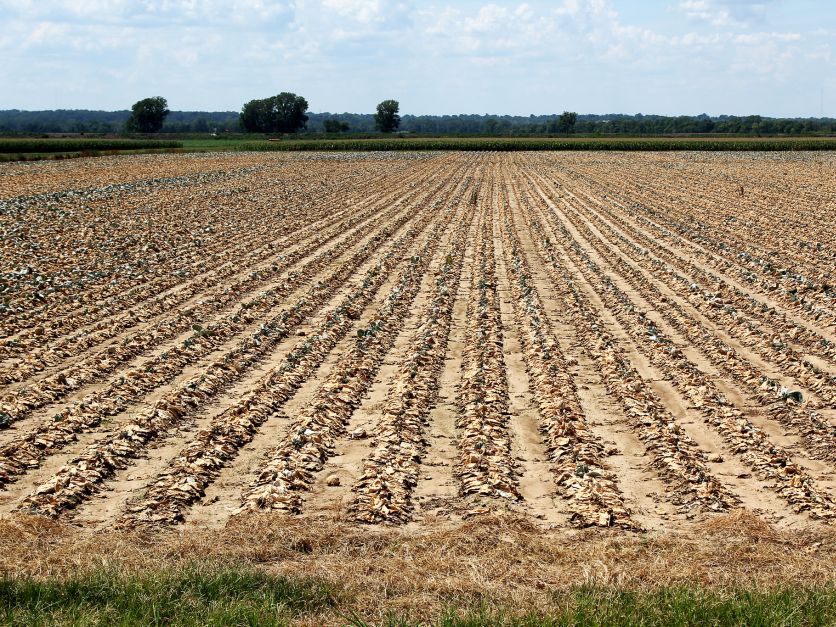Time is growing short to address global climate change, whose impacts are being seen in more extreme weather events such as drought and heavier precipitation, and changes to agricultural practices could take decades to have an impact on carbon emissions, according to a new report from the Intergovernmental Panel on Climate Change.
The report "is a code red for humanity," the United Nations panel said. "The alarm bells are deafening and the evidence is irrefutable: greenhouse gas emissions are choking our planet & placing billions of people in danger."
The report says that carbon dioxide levels in 2019 were the highest in the last 2 million years. Increases in carbon dioxide have a mixed impact on crops; high carbon dioxide levels can spur plant growth, but they also trap more heat, which can reduce yields.
Humans are almost undeniably the cause, the report says. “Eight years ago we weren’t completely sure whether some of the extreme events we’re seeing were due to human-caused climate change,” said Jessica Tierney, an associate professor of geosciences at the University of Arizona and a co-author of the report. “Now we’re pretty sure that that is the case.”
Examples of the impacts may include “the extreme heat waves that we’re seeing around North America right now,” she said in comments on the report collected by the American Association for the Advancement of Science. “This new report says that those heat waves were unlikely to occur without human climate change.”
“The report provides new estimates of the chances of crossing the global warming level of 1.5°C in the next decades, and finds that unless there are immediate, rapid and large-scale reductions in greenhouse gas emissions, limiting warming to close to 1.5°C or even 2°C will be beyond reach,” the IPCC said in a news release.
“The report projects that in the coming decades climate changes will increase in all regions,” the IPCC said. “For 1.5°C of global warming, there will be increasing heat waves, longer warm seasons and shorter cold seasons. At 2°C of global warming, heat extremes would more often reach critical tolerance thresholds for agriculture and health.”
Changes in agricultural practices can begin to sequester some of the carbon released by agriculture over millennia, the report says, but such changes could take decades or longer to have an impact.
“Removing more CO2 from the atmosphere than is emitted into it would indeed begin to reverse some aspects of climate change, but some changes would still continue in their current direction for decades to millennia,” the report says.
It cites crop rotation, an increase in the amount of crop residues, use of cover crops, “optimization of grazing” and no-till or low tillage as among those beneficial practices. “With medium confidence, methods which seek soil carbon sequestration will diminish [nitrous oxide] emissions and nutrient leaching, and improve soil fertility and biological activity,” the report says.
However, “Some parts of the climate system take time to react to a change in CO2 concentration, so a decline in atmospheric CO2 as a result of net negative emissions would not lead to immediate reversal of all climate change trends,” the report says.
Interested in more coverage and insights? Receive a free month of Agri-Pulse West
“Recent studies have shown that global surface temperature starts to decline within a few years following a decline in atmospheric CO2, although the decline would not be detectable for decades due to natural climate variability,” the report says.
The report says with more certainty than previous reports that humans are behind the increase in extreme weather events.
“In general, the attribution of extreme weather events to human-caused climate change can now be made with higher certainty, and we now have increased evidence that extreme events are becoming both more frequent and more severe,” said Linda O. Mearns, senior scientist at the Research Applications Lab of the National Center for Atmospheric Research.
“Human influence very likely contributed to the observed increase in heatwaves and likely contributed to the increased intensity of heavy rainfall,” she said. “Increases in weather conditions favorable to fire and some aspects of drought in the Western U.S. have also been linked to human-caused climate change.”
The effects of a 1.5 degree Celsius increase in warming would be devastating, the report said. But changes witnessed so far, such as extreme weather events, “are associated with around 1 degree C of warming,” said Mathew Barlow, a climate science professor at the University of Massachusetts-Lowell. “Limiting warming to the 1.5 degree C target of the Paris Agreement would require immediate, rapid, and large-scale reduction in greenhouse gas emissions.”
That agreement, signed by nearly 200 nations, seeks to keep the global temperature rise to 2 degrees Celsius and encourages countries to become carbon-neutral by 2050.
“Sustained reduction in carbon dioxide emissions would become apparent in atmospheric concentration after 5-10 years and in the temperature after 20-30 years,” the report said.
In the central and western U.S., “Increases in drought and fire weather ... will continue to increase in the future particularly at higher warming levels,” the report said, also calling a projected increase in extreme precipitation “very likely.”
"Fire weather" is defined in the report as "a combination of hot, dry, and windy conditions."
For more news, go to www.Agri-Pulse.com


